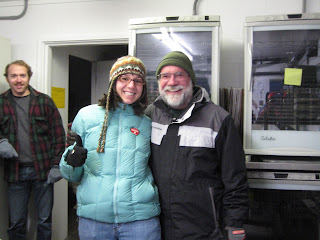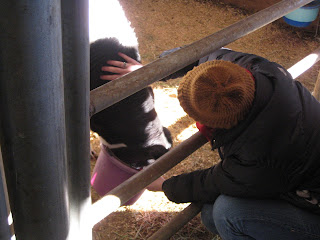This week I made Spinach Feta rolls.
For 12 rolls you need:
½ cup packed, cooked spinach (steamed, boiled, chopped; frozen or fresh)
½ cup feta cheese
1½ cups warm water
1 Tablespoon plus 1 teaspoon yeast
½ Tablespoon salt
1 Tablespoon sugar
3¼ cups flour (I mixed half whole wheat and half unbleached white)
Cornmeal for the pan
Put the yeast, salt, sugar, spinach, and feta into a large bowl. I would recommending breaking up the feta chunks so they are smaller.
Pour in the warm water and stir to mix well.
Then pour in the flour all at once, mix thoroughly with a wooden spoon.
Cover (not airtight) and let it rise in a warm place for 2 hours, then store overnight in the fridge. Or, if you would like to bake it right away, then do so!
When you are ready to bake, coat your hands in flour and sprinkle a generous amount of flour into the counter. Take out about half of the dough and break it into 6 even portions, rolling them into nice, even balls, coating in flour. When formed, lay them on a pan with cornmeal sprinkled on it to prevent the rolls from sticking.
Let them rise for 40 minutes if you refrigerated them, 20 minutes if you are baking right away.
While they are rising you can slash the dough - I found that using a serrated knife worked much better than the smooth parry knife I was using. Live and learn!
Some solid advice from my cousin-in-law Blake on slashing bread: "the cuts in the dough make the bread attractive looking, but they serve a function as well. The cuts in the dough give the bread a place to relieve the tension in a controlled way. My technique is to cut once after shaping and before rising, and again after the dough has risen and before baking. The first cut is so that the dough rises in the shape you want. the dough will "fill in" those cuts while rising, so I cut it a second time before baking so that when the loaf is in the oven, it does not tear apart. I have learned to avoid letting the cuts touch each other, ie in a cross pattern or something, because the "point" formed at the intersection burns in the oven. Also you might want to try cutting a little deeper; when the bread rises it will fill in those cuts."
I followed that advice with these rolls - and it seems to work very well!
Bake them in the oven for 20-25 minutes at 450°F; pour some boiling water in a pie tin and place it in the oven when you put the rolls in.
Still not perfect - you can see the tear in the roll on the far right side of the picture.
Honestly... they were good rolls, but the spinach and feta didn't really come through as distinctly as I would have hoped. I think next time I might increase the amount, though it is, after all, a roll. Ross told me that if I wanted to taste the spinach I should just eat spinach, and the same for feta. Well, isn't he just a smarty pants.
_______________________________________________________________
And how about a simple soup recipe for anyone still suffering from the we-are-almost-getting-to-the-end-of-winter-no-more-snow-I'm-sick-of-it syndrome. No, we haven't had enough snow here to complain, but my mother-in-law back in the Twin Cities is ready for Spring!
Tortellini Soup - mostly from the Fix-it and Enjoy-it 5 Ingredient cook book. It is a pretty good cookbook, and was great when I was first getting into cooking, but it does not quick meet my desired level of challenge anymore. However, this recipe is a favorite soup of ours!
I've adapted the recipe a bit, and this is how I make the soup (see, more than 5 ingredients):
1 medium onion, chopped
1 red bell pepper, chopped
2 or 3 garlic gloves, minced
2 Tablespoons oil to sauté
1 28oz can diced tomatoes
1 32oz box of vegetable stock
3 cups water
16oz of tortellini
2 cups of fresh or frozen chopped spinach
spices and herbs: oregano, basil, parsley, salt and pepper
Then add in the stock, water, and canned tomatoes. Bring to a bowl and simmer for about 15 minutes, or until the tomatoes are tender enough to mash.
Once the tomatoes are tender, add in the tortellini and spinach if it is frozen. Wait until the tortellini are almost done if you are using fresh spinach. Cook for about another 10 minutes, until the tortellini are tender.
Add seasonings al gusto, and serve with fresh Parmesan cheese and some spinach feta bread!
I like to cover mine with crushed red pepper flakes for spice.
This recipe makes probably 8-10 servings; a great recipe for lots of easy, tasty leftovers!






















































